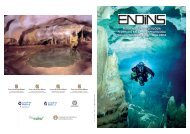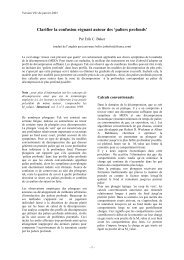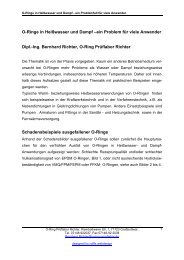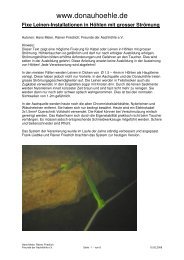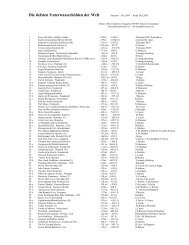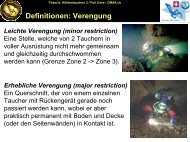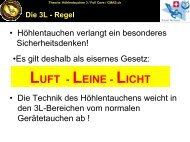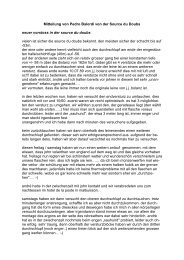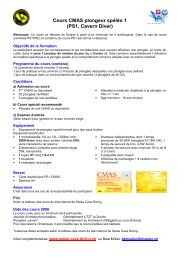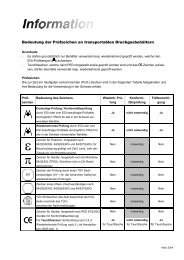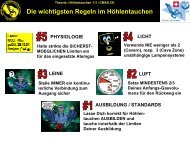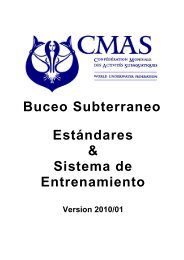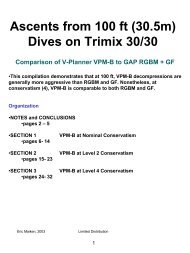cave diving and the nss - bei Swiss-Cave-Diving
cave diving and the nss - bei Swiss-Cave-Diving
cave diving and the nss - bei Swiss-Cave-Diving
You also want an ePaper? Increase the reach of your titles
YUMPU automatically turns print PDFs into web optimized ePapers that Google loves.
20 HAND SIGNALS<br />
HAND SIGNALS 21<br />
an "Okay" signal. Your buddy may be pointing out some interesting<br />
feature of <strong>the</strong> <strong>cave</strong>, such as animal or plant life, an unusual formation,<br />
a side tunnel, <strong>the</strong> strength of flow, a special location discussed<br />
on <strong>the</strong> surface, or organic debris indicating a nearby access or<br />
strong flushing of <strong>the</strong> <strong>cave</strong>. Or he may be calling your attention to<br />
some technical item such as a line marking or configuration, or reel<br />
placement. Or he may regretfully be pointing out some form of<br />
v<strong>and</strong>alism or accidental damage to <strong>the</strong> <strong>cave</strong>. The observation may<br />
ei<strong>the</strong>r be made with a h<strong>and</strong> signal, pointed light beam, or some<br />
combination of both.<br />
The communication of some of <strong>the</strong>se problems, questions,<br />
warnings, etc., may be fairly complex, involving a lengthy series of<br />
signals. A question, for example, may begin with <strong>the</strong> "Question"<br />
sign, be followed by pointing to some item of gear, such as a<br />
pressure or depth gauge, <strong>the</strong>n be fur<strong>the</strong>r qualified by pointing to<br />
<strong>the</strong> o<strong>the</strong>r diver to indicate whose gear. The answer may involve a<br />
series of numbers, indications of <strong>bei</strong>ng close to turn or <strong>bei</strong>ng at<br />
maximum desired depth, desiring to go no deeper, etc.<br />
Nouns such as "tunnel," "current," "bubble," or "problem," may<br />
be qualified by adjectives such as "big," "little," "bad," or "silty."<br />
Verbs such as "swimming" or "tying off <strong>the</strong> reel" may be modified<br />
with adverbs such a "slowly" or "quickly." The movement of items<br />
or divers from place to place can be expressed by describing a<br />
progression of objects <strong>and</strong> events in <strong>the</strong> approximate order that<br />
<strong>the</strong>y would occur in <strong>the</strong> simplest, most straightforward of spoken<br />
sentences. For example, "You - hold here - I - operate reel - over<br />
<strong>the</strong>re - tunnel - point to watch - small - hold here" equals "You wait<br />
here tor just a minute while I take a quick look-see with one of my<br />
jump reels in that tunnel; I'll be<br />
right back so just wait right<br />
here for me," with <strong>the</strong> fur<strong>the</strong>r<br />
probable implication that if it<br />
looks good, he'll <strong>the</strong>n motion<br />
"QUESTION" + (point lo watch) =<br />
"What time is it?"<br />
you to follow. Although, with<br />
an experienced exploration<br />
team making a dive, <strong>the</strong> specific<br />
purpose of which is to<br />
check out side leads, it may be<br />
necessary to do no more than<br />
signal "Hold," if even that.<br />
"KNIFE"<br />
Make a sawing or<br />
slashing motion.<br />
"GAP LINE"<br />
May be used to refer to ei<strong>the</strong>r<br />
a gap or jump line.<br />
"TANK"<br />
Make a motion at least a<br />
foot high, simulating a<br />
cylinder.



